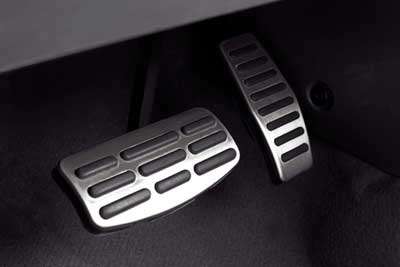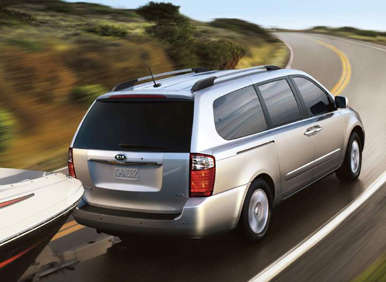Recent Articles
Popular Makes
Body Types
Cheap, Fast, and Easy: Hypermiling Tips

With the price of fuel well above four dollars a gallon in most of the country, many people are starting to think conservatively, regardless of their political leanings. Of course by conservative, we mean conserving their cash and conserving fuel. Most of us know basic concepts for driving more fuel efficiently, but there is a group of drivers out there obsessed with milking every possible mile per gallon of fuel out of their automobiles.
These people are referred to as hypermilers. For them, operating their vehicles in as fuel-efficient manner as possible is like getting free gas. Like most groups, they have a language of their own, a raft of readily employable techniques, and an acknowledged leader. In the case of hypermiler, the leader and the man credited with coining the term hypermiler is Wayne Gerdes.
And while some of their techniques are questionable in terms of their overall safety, a number of them can be implemented without any real experience, or putting yourself in potentially hazardous situations. Many are common sense when you think about them, while others require a bit of explanation. The basic idea though is to get as much “free” motion out of your vehicle as possible.
Hypermiling Tips: Driving Behaviors
The idea behind this hypermiling tip is to keep your car at as constant a speed as possible and maximize momentum. Once you’ve expended the fuel to get your car up to speed it takes less fuel to keep it moving. Braking heavily trades away momentum, causing you to have to accelerate again to get back up to speed. Try to look ahead and anticipate anything that will make you have to stop. Then, rather than stopping for it, slow down enough so that the obstruction, traffic signal, or whatever will be clear by the time you get to it—so you don’t have to stop.
The faster you travel, the greater the effects of aerodynamic drag on your automobile. It also increases the mechanical friction your car must endure. Driving at moderate speeds means your car doesn’t have to work as hard to remain in motion. With this hypermiling tip, less work for the car equals less fuel consumed.
If your destination offers a choice between driving over flat, nicely paved roads and hilly or mountainous terrain, the better choice for fuel economy is going to be the flat land.

Hypermiling Tips: Driving Behaviors - Contd.
Try to group all of a day’s errands into one outing. Plan your tasks so you drive to the one the farthest away first, and then work your way back home going to each successively closer destination. This gets your car good and warmed up so it can operate at maximum fuel efficiency.
. Running your engine when the car isn’t moving gets you zero miles per gallon is the premise guiding this hypermiling tip. If you’re going to be stopped for seven seconds or longer, shut the engine off. Similarly, idling your car to warm the engine before driving wastes fuel. Modern cars are perfectly happy to be driven gently while they get up to optimum operating temperature. They do use slightly more fuel until they’re completely warmed up, but just sitting with the engine running to get up to temperature means the car is getting no miles per gallon at all.
Driving with excess cargo in the trunk, or carting around items you don’t need on a daily basis is wasteful. Similarly, cargo racks on top of your auto add weight and ruin its aerodynamics. Excess weight and excessive drag combine to destroy fuel efficiency. Towing is another activity to avoid whenever possible for the same reasons, increased drag and excess weight.

Hypermiling Tips: Caring For Your Automobile
A properly tuned engine uses less fuel. Also pay close attention to the alignment of your wheels. If your car is pulling to one side or another it’s encountering increased friction, which means it’s working harder than it needs to and using more fuel than it should be.
The optimal tire pressure for your vehicle can usually be found on a sticker in the lower part of the driver’s doorframe. While running your tires at the maximum recommended pressure will reduce rolling resistance and improve fuel economy, it is important to note overinflating your tires can lead to dangerous loss of control situations.
This hypermiling tip is useful if you’re after max MPGs to the exclusion of even tire wear It will also cause you to have to put up with the increased road noise and harshness that running your tires at their maximum inflation rating entails. If those issues don’t concern you, then this is one way to go. With that said, while we can say it works, we are somewhat reluctant to be considered to be recommending it. The maximum recommended pressure on the sidewall of the tire might not be the optimal pressure for your auto. In our opinion, you’re safer adhering to the recommendations on the sticker. But running the tires at the maximum recommended pressure will improve your MPG performance.

Hypermiling Tips: Caring For Your Automobile - Contd.
Your choice of motor oil can also effect the fuel economy your car achieves. Generally speaking, the lightest oil your car can safely be operated on is the most fuel-efficient choice. This hypermiling tip is important because motor oil actually resists movement—ever so slightly—within your engine. By switching to lighter weight synthetic oil, you can reduce the amount of friction inside your engine and help it burn fuel more efficiently.
Another thing you can do to reduce the friction oil imposes upon your engine is to only fill the crankcase to the halfway mark of your dipstick. Yes, this will mean you need to keep a closer eye on your oil level, but you’ll be carrying less weight and the extra oil in the crankcase creates more friction for your engine to deal with. As long as your oil level is above the minimum mark on the dipstick your engine is safe.

Hypermiling Tips: Special Driving Techniques
Most modern cars come equipped with a fuel economy gauge. More than just an oddity, the gauge is a useful tool for helping you to maintain the highest possible average fuel economy. To employ this hypermiling tip, once you reach cruising speed, keep your gas pedal locked at the angle that maximizes the MPG reading on your fuel economy gauge.
For example, instead of applying more throttle to climb a hill, maintain the same amount of pressure on the pedal. Yes, your speed will drop, but your fuel consumption will remain constant. And no, cruise control does not do the same thing, because cruise control tries to maintain a constant speed, thus it will apply more throttle to climb the hill.
Most streets have two depressions in them where the majority of the traffic has driven and created a pair of grooves in the pavement. In wet weather, these grooves hold water and allow puddles to form. This can increase the amount of fuel your car uses as it works to overcome the resistance of the water. To alleviate this, drive on the ridges. Move over slightly so your tires are out of the grooves and instead are on the ridges that mark the edges of the grooves. This keeps you out of the water and lets your car travel more freely in wet weather.

Hypermiling Tips: Special Driving Techniques - Contd.
If you’ve ever ridden a bicycle with no brakes, or driven a car with diminished brake performance, you know you have a tendency to look farther ahead and anticipate obstacles that might cause you to have to stop. Driving as if you have no brakes, you’ll maintain a more regulated average speed and you’ll avoid the hard throttle starts and sharp braking which diminish your fuel economy. This hypermiling tip is particularly effective in traffic jam situations.
Next time you’re caught in a traffic jam on the highway, if you pay attention, you’ll notice the heavy truck drivers always leave a huge gap between themselves and the vehicles they follow when stuck in traffic. This helps them minimize starts and stops so they don’t have to work as hard to keep the big truck moving. You can do the same thing in your car and save fuel.
In fact, if everyone drove this way, there’d be no traffic jams because the space left between the cars would make it easier for everyone to maneuver without stopping.

Hypermiling Tips: Special Driving Techniques - Contd.
Every time you stop your car it uses more fuel to get started again. Minimize your restarts, you'll maximize your miles per gallon. That said, whenever you’re confronted with a red traffic signal, you want to approach it as slowly as possible to give it time to change before you have to come to a complete stop. Let the cars in front of you wait at the signal and trigger its sensor to change it before you get there and have to stop too.
If you find yourself forced to stop for a traffic signal or a stop sign on a hill, travel as far up the hill as possible before you stop your vehicle. That way, when you restart you won’t have as much of the hill to climb from a dead stop. Going downhill, you also want to stop as far up the hill as possible. But in this case, you’re stopping higher up the hill so you can use the hill to help get you started rolling again.

Hypermiling Tips: Additional Strategies
Because the whole idea is to try to get as much free motion as possible, there are some hypermiling tips you can use when parking too. Finding the highest spot in the parking lot will give you the benefit of gravity when it is time to leave. It also enables you to minimize brake usage when parking. Yes, you may have to walk a bit farther to get in and out of the store, movie theater or whatever, but you’ll save fuel and you’ll get more exercise.
Whenever possible, park facing out. If you combine this hypermiling tip with potential parking you can almost get your car moving without starting your engine (almost). Parking facing out enables you to just drive away when you depart, rather than backing and turning and wasting fuel trying to maneuver your way out of the parking space. Yes, you’ll have to do it when you park, but your engine will be warm and operating in its most efficient state. After you’ve been parked for a while and return to the car, the engine might be cold and you’ll be doing all of that maneuvering with your engine operating at its lowest efficiency level. You’ll especially want to do this at home, as your car will almost always be cold when starting first thing in the morning.

Hypermiling Tips: Additional Strategies - Contd.
Thishypermiling tip applies more to hybrids than conventional cars. Even a cursory study of the EPA figures for hybrids show they get better fuel economy in the city than they do on the highway. This is because there are more opportunities for the hybrid powertrain to operate without using its internal combustion engine. Thus, when you have a choice between getting someplace in a hybrid on a freeway at a constant 65 miles per hour, or using city streets and averaging 40 miles per hour in stop and go traffic, you’ll almost always achieve better fuel economy on the second route than the first.
